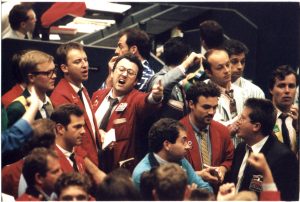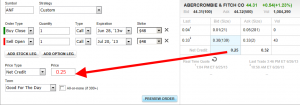 I’ve recently received a few questions about the mechanics of making trades.
I’ve recently received a few questions about the mechanics of making trades.
Specifically, the questions revolve around making paired trades and how they are done, especially with the potential for prices to be moving around, as they can do even with the most sedate of stocks and especially during periods of volatility.
There are a number of different ways to go about making the most common paired trades, the Buy/STO and the Rollover
The Buy/STO is more commonly referred to as a Buy/Write and involves buying shares of a stock and then selling calls, in that order.
The process can be done in individual steps or it can be done as a single step.
The double step process involves buying your shares by entering your bid. Once the sale is completed you have the opportunity to sell calls on the shares. You can then submit a “Sell to Open” trade, entering your “Ask” price and then waiting for completion of the option trade.
The downside to the two step procedure is that there can be price movement between buying shares and wanting to sell calls that results in you getting less of a premium if share price goes down. You would probably prefer for that not to happen, although you might be happy if the share price went higher. Since it’s often a bad idea to chase a stock whose price is actively moving higher, the greatest likelihood is that you will be on the losing side if you’re unable to get the call sale completed.
That can be avoided by using the single step procedure.
In that process instead of designating a bid for your shares and an ask for your calls you state the “differential” between the two. In other words, after you buy shares and sell calls, how much will it end up costing you? It is the price you paid for shares less the premium you received.
Buy/STO
 Every brokerage will have its own interface or proprietary software, but the essence of the trade and the mechanics are the same.
Every brokerage will have its own interface or proprietary software, but the essence of the trade and the mechanics are the same.
In the case of a Buy/Write you must specify the price differential in terms of a “Net debit.” That means that is the net amount that will be debited from your account if the trades are executed (plus commissions).
In this example the program does the math for you.
However, if yours does not, just ask the following:
1. What is the “Ask price” to buy shares?
2. What is the “Bid price” to sell calls?
Obviously you aren’t tied to these bid and ask prices. You can always place your own so that the transaction is more in line with your own perception of value.
But if the bids and ask prices are acceptable, then subtract #2 from #1 and enter that as your “Net Debit.” If there is a large spread between Bid and Ask prices for either the stock or the calls, then you can try splitting the difference. For example, in the case above the option bid is $1.60, while the ask is $1.70. Rather than entering a “Net Debit” of $48.21 you might enter a Net Debit of $48.15. That $0.05 difference can come from either the stock portion of the transaction or the option portion, or both. While the bid and ask may be $1.60 and $1.70 respectively, you may find that your trade was executed at $1.63. Had you entered that price directly, it may have been refused by the clearing house as they may only take bids and asks denominated by $0.05 increments for that particular position.
Because you can’t directly enter such fine tuned bids or asks, when I send trading alerts I use the lower figure when selling and the highest when buying in order that the ROI more accurately reflect what people may experience if entering trades as individual transactions. Those utilizing pricing differentials may achieve higher ROI when there is a spread larger than a penny or two.
Additionally, you are more likely to get that preferential price if dealing with less than 1000 shares and less than 10 contracts. If that is the case do not check the “All or none” box. Trading regulations for market makers favors the completion of trades for smaller lots.
You can also get an idea of the prospective trading volume and distribution by looking at the “Market Depth” if your software offers that feature. That will show you the size of the bids and asks at various prices to give you an idea of how likely it may be to complete a transaction based on supply and demand.
That is more important for those making the transaction in two separate trades rather than based on differentials. For example, if the bid to buy is $1.65 and you are willing to accept that amount, you may end up disappointed seeing that your options were not sold. The issue may be that the bid to buy contracts at $1.65 was for only 3 contracts and you were trying to sell 12 contracts. In that case you can either not check the “All or none” box and perhaps some contracts will be sold at $1.65 or if you really want to sell all contracts you would check the “All or none” box and place an ask at that bid price where there is enough demand to meet your need to sell all of your contracts.
Rollovers
Now, the next paired trade that is made
with frequency is the “Rollover” trade. It is also called a “Spread.” Most commonly in our case it will be a “Call Spread” in which you seek to close your existing sold options and then sell new options.
Again this can either be done as two separate trades or as a single process. Doing it as individual trades involves first executing a “Buy to Close” transaction and once that has been completed executing a “Sell to Open” transaction for the new call contracts. Of course that runs the same problem as described above for Buy/Writes. It isn’t very nice to close one leg and then see the opportunity to sell a new leg disappear.
Instead, by doing the trade on the basis of the price differential between the two legs of the Rollover the first trade will only be made if the second trade can be made. The actual prices are irrelevant as it is the difference in premiums that is of importance.
In the case of Rollovers, when it’s all said and done you should have a “Net Credit,” because the cost of buying back your call options should be less than the premium you receive for now selling new options.
In this case you initiate a “Spread” transaction:
 For less than 1000 shares or less than 10 contracts, do not click the “All or None” box, especially if the difference between bid and ask prices on the calls are more than a few cents.
For less than 1000 shares or less than 10 contracts, do not click the “All or None” box, especially if the difference between bid and ask prices on the calls are more than a few cents.
Again, in this case, the program has done the math.
However if yours doesn’t do the same, then ask the following questions:
1. What is the Ask Price to buy back the options I wish to buy?
2. What is the Bid price onn the shares I want to sell?
As before, it’s simple subtraction, but this time subtract #1 from #2 to arrive at a “Net Credit.”
The process of using premium differentials is also an important way to assess when it makes sense to do a Rollover trade. Option pricing dynamics vary as stock prices vary from their strikes and as the clock is ticking away. For example, when comparing an expiring option premium versus a premium expiring next month, a move in a stock’s price may have relatively greater impact on one premium versus another and the differential when doing a rollover can change substantially.
I anticipate that by July 1, 2013 Trading Alerts will also provide either a Net Credit (NC) figure or a Net Debit (ND) figure such that a typical paired Trading Alert will look like:
“Buy L Brands (LTD). STO $50 July 20, ’13 calls. Currently $49.73. Premium $1.05 bid. ND $48.68. TRADITIONAL”, or
“Rollover. BTC Lorillard (LO) $43.33 June 22, ’13 calls. STO Sept. 28, ’13 $45 calls. Currently $42.94. Premium to buy $0.13 ask. Premium to sell $1.30 bid. NC $1.17”
One final thing, and that is while the Trading Alerts will still give the bid and ask parameters of the trades, the NC or ND amount may not be the result of simply subtracting bid from ask. That’s because in cases that the bid and ask may not allow you to enter a denomination, such as a single penny, in the case where bids and asks are denominated by say $0.05, the use of a spread can get a penny denominated price that will be better than if you had made individual trades.
For purposes of performance calculations, however, I’ll continue to use the more conservative bid and ask prices.
As always, I welcome comments, observations or suggestions.

Csókold meg a seggem